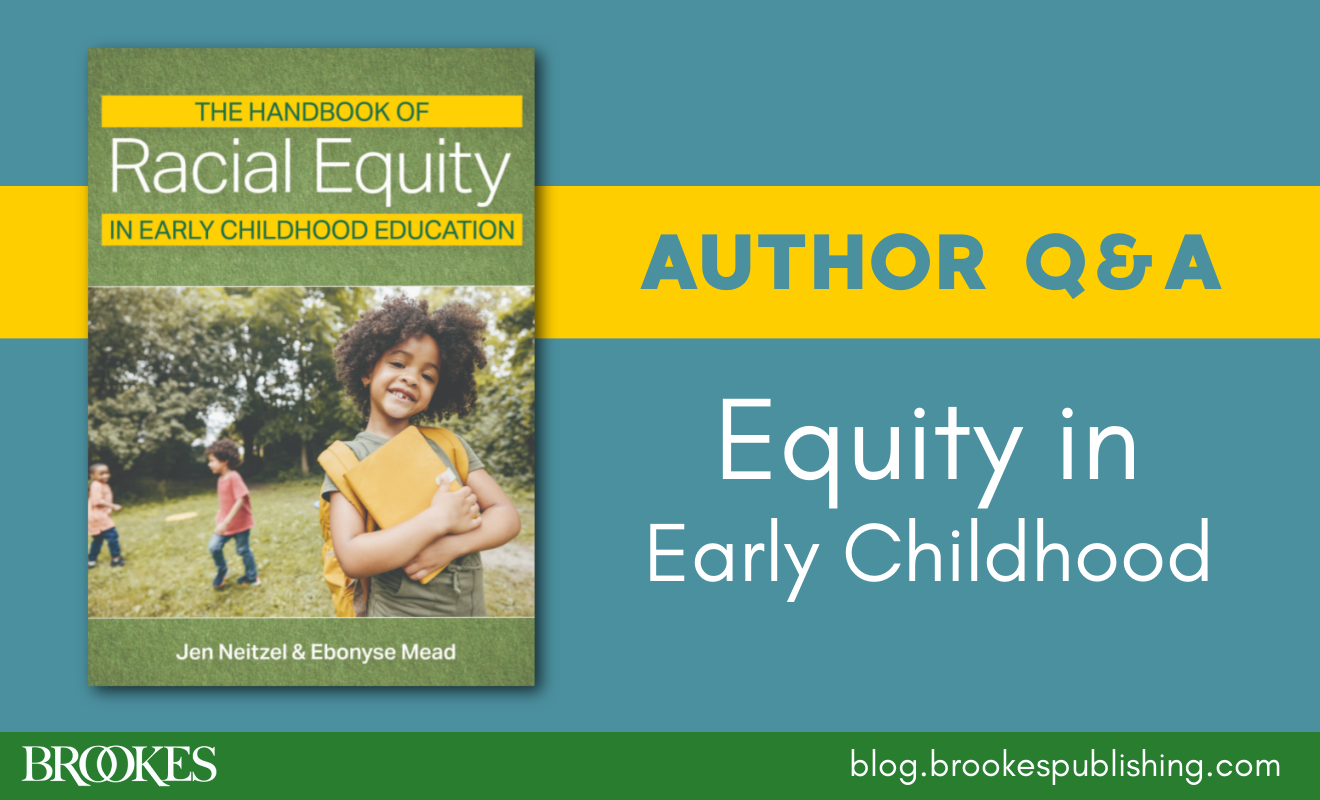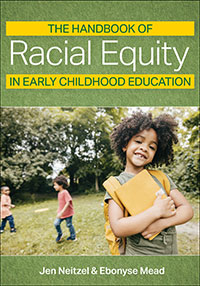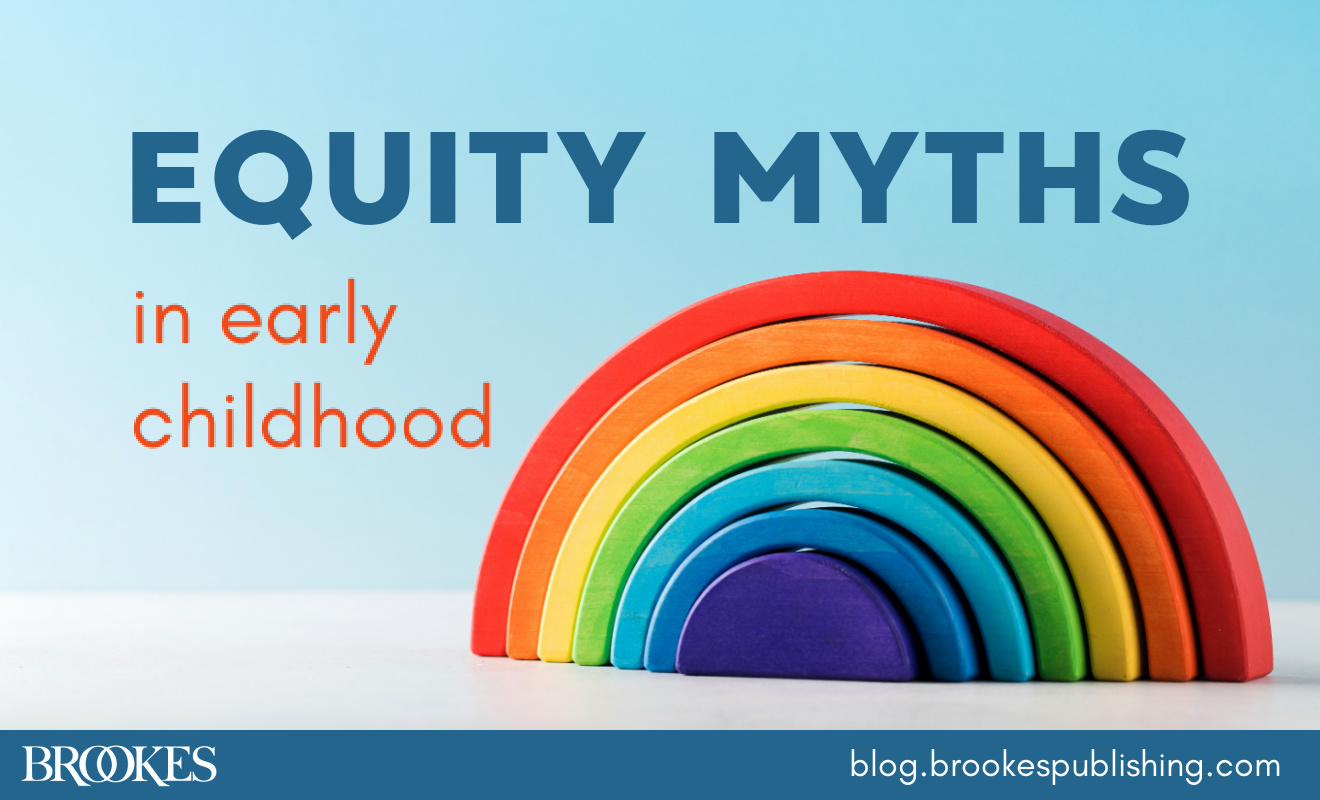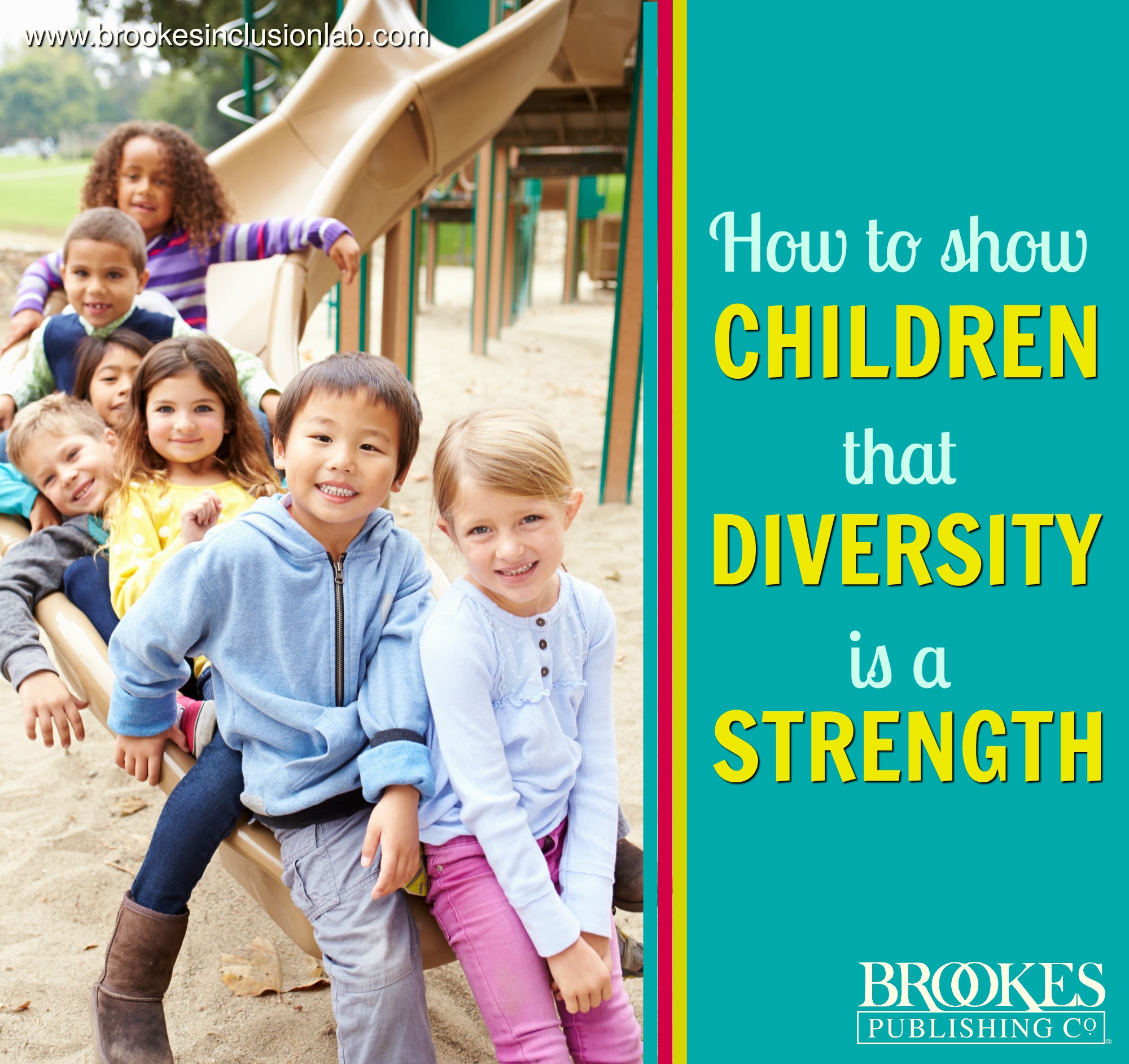“Anti-Bias Practices Are Good for All Children”: An Equity Q&A with Jen Neitzel & Ebonyse Mead
May 25, 2023
 Every early educator wants to give each child a bright start—and a big part of that goal is dismantling the biases and inequities that have created an achievement gap for young Black children. Authors Jen Neitzel and Ebonyse Mead are doing excellent work to transform practices and work for systemic change in early childhood. Today they’re here to talk about their new book, The Handbook of Racial Equity in Early Childhood Education, and share their insights on how to break down barriers and get other education professionals on board with equity work.
Every early educator wants to give each child a bright start—and a big part of that goal is dismantling the biases and inequities that have created an achievement gap for young Black children. Authors Jen Neitzel and Ebonyse Mead are doing excellent work to transform practices and work for systemic change in early childhood. Today they’re here to talk about their new book, The Handbook of Racial Equity in Early Childhood Education, and share their insights on how to break down barriers and get other education professionals on board with equity work.
WATCH A WEBINAR!
Achieving Equity and Justice in Early Learning Programs
Watch a free coffee chat with the authors to explore systemic inequities based on race that continue to adversely impact the educational outcomes of young Black learners. Attend the webinar live on July 27 at 2:00 pm ET, or access the recording at the link below anytime.
First, could you tell us a little about how your partnership came about, and your main goals in coming together to write this book?
We met seven years ago—we had put in very similar proposals for a full day workshop on implicit bias at a state early childhood conference. The organizers of the conference reached out to both of us and wanted to know if we would be willing to present together. We both said yes even though we had never heard of each other, even though we had both been working in the space of early childhood in North Carolina.
When we started planning for this workshop, we communicated through email and phone calls (this is before Zoom was a big thing). We did not meet each other until the day of the workshop. We had no idea about each other’s presenting styles or personalities; however, it was like we had known each other our whole lives. It was just easy. That doesn’t happen very often.
Two years later, we were partners in the Educational Equity Institute. We have been working together since then, and we have become very good friends. We can’t imagine doing this work with anyone else.
Equity is a critical topic, and fortunately more books are being published to help educators advance equitable practices for young learners. What are the features or areas of focus that will set your book apart from other resources on this topic?
Since we first became true partners at the Educational Equity Institute, we have learned a great deal about the issues, ourselves, and the work itself. It is one thing to sit in an office and talk about equity at an intellectual level. It is something altogether different to actually do this work with early childhood professionals.
Before the murder of George Floyd, we were very much engaged in cultural competence work and more traditional diversity, equity, and inclusion trainings that serve a purpose, but tend to skirt the really hard stuff. After George Floyd was murdered, our work changed drastically. We both realized that our whole country was in pain. We realized that all of us have been affected by white supremacy and racism, regardless of race or ethnicity. So, we shifted the focus in our trainings to emphasize the importance of racial healing. We also began talking more in-depth about issues that many within our society are afraid to talk about (e.g., racism, white supremacy, whiteness, anti-blackness). We firmly believe that racial equity and justice in our society cannot be attained until we reckon with our history, and how its effects show up presently in the form of ongoing oppression, including within early childhood.
Our book is different from anything out there. Through our work in the field, we have gained a better understanding of the knowledge needed to truly work to address the ongoing disparities in early childhood. We have provided a comprehensive book that is truly intended to be a handbook. Building knowledge is absolutely critical; however, we also want people to move out of the headspace into the heart space. Yes, an understanding of the issues at an intellectual level is essential, but we also need to understand the issues from a shared humanity perspective. The issues cannot be in the abstract. We have to commit to an intentional urgency that none of us will be free until all of us are free.
We have to commit to an intentional urgency that none of us will be free until all of us are free.
When approached with the idea of equity work, some teachers might default to defensiveness, responding that they already “treat all kids the same.” What is the message these professionals need to hear to break through that wall and understand why this work is so important?
When we start our trainings, we always begin with a set of assumptions. One of those is “We all believe that no child’s skin color should fate him or her to negative outcomes.” That is something that we can all agree on. So, yes, we understand when educators say that they treat all kids the same way. We also understand that kindness, compassion, and empathy are the foundation of our field. Most of us went into early childhood because we understand the power of those early relationships and learning experiences. These thoughts and feelings are grounded in colorblind racism, which is the foundation of current practices within the field.
We must, as a field, begin having conversations about how early childhood education is not immune from racism. However, it is not enough to talk about racism. Most people, when they think of racism, think of racist acts from one person to the next. We want to push people beyond thinking about racism at an individual level to a point of understanding that whiteness and anti-blackness permeate every aspect of our society, including early childhood education. There are key disparities in early childhood, including suspensions and expulsions, that will not go away unless we dig deep into the ways in which early childhood programs are set up and for whom.
For example, when we look at the major theorists and pioneers in the field, they are primarily White. We understand and value these theories and manifestations of what early childhood should look like; however, we must expand our definition of quality to include additional voices about what that might look like for Black children and other children of color. We need to provide spaces where all children feel safe and feel that they matter simply because they exist. To do so, we must engage in self-reflection about our beliefs (including about early childhood) and how we show up in spaces for young children. We must push educators to understand that all children see race and begin placing value on it from a very early age. Our early childhood programs offer children a space to develop the key skills needed to have authentic, cross-cultural relationships that are desperately needed at this time.
We need to provide spaces where all children feel safe and feel that they matter simply because they exist.
Some early educators may not talk about race with young children because they’re afraid kids that age “aren’t ready.” Why is it important to discuss race with kids from an early age, and what are some steps teachers can take to integrate these conversations in their classrooms?
Many of us do not realize that young children begin to notice race at a very early age. For example, babies as young as six months of age show preferences for individuals from their own race. By four and five, children begin to place value on skin tone, not necessarily by what they are experiencing at home, but more so in the messages that they receive through media, TV, picture books, toys, and larger society. Recently, a graduate student replicated the Doll Study that was conducted by Kenneth and Mamie Clark in the 1940s. In this recent study, both Black and White children show preferences for the White dolls and assign them as good (White dolls) and bad (Black dolls).
We can no longer pretend that children aren’t ready or don’t see color. We can have developmentally appropriate conversations and activities about race by reading picture books with Black children and other children of color as the protagonists. We can talk about fairness and unfairness. We can have conversations with children about how melanin determines skin tone. We can engage children in conversations where they talk about similarities and differences among the children in the class in a very normalized way. We can help children develop positive identities by having activities where they choose their eye color, skin tone, etc. These are all incredibly important.
We cannot shy away from talking with young children when they bring up race. We must normalize talking about race with young children. It is when we place our own discomfort on young children that we perpetuate the idea that talking about race is taboo. We must explore our own discomfort in talking about race so that we break the cycle with the children we care for.
We must explore our own discomfort in talking about race so that we break the cycle with the children we care for.
For early childhood programs in some locations—for example, in states where anti-CRT legislation has taken hold—equity work may be viewed with suspicion and even hostility. Do you have suggestions for individual administrators who want to proceed with this essential work in a challenging political environment?
Anti-racism work has definitely become more challenging in recent years. First, it is really important that administrators and educators research the law within their state. For example, it makes a difference where early childhood is housed. In some dates, early childhood is comprised within the Department of Education. In other states, it is part of the Division of Early Childhood or Child Development. Most, if not all, of these laws only pertain to K-12. Therefore, equity work can advance in early learning programs by implementing practices that are beneficial for all children, such as talking about similarities/differences; painting self-portraits; reading books with Black and Brown characters; talking about fairness/unfairness; having pictures of children and families with various skin tones (i.e., very light to very dark) and hairstyles (e.g., braids, afros, poofs, dreads) and talking with children about them.
Equity-related efforts should not and don’t have to be divisive or politicized. CRT is a graduate-level class that is not part of any early childhood or K-12 classroom. Equity work with young children is about helping them recognize their shared humanity and interconnectedness.
Equity-related efforts should not and don’t have to be divisive or politicized.
“Deconstructing whiteness” is a term some teachers will have heard, but they may be unsure of how it applies to them and their day-to-day work. What might deconstructing whiteness look like for a white early childhood educator?
Deconstructing whiteness is a key part of equity-related efforts. This must be done on a personal, professional, and organizational level. Personally, this is essentially self-education and -reflection. Learning and introspection are absolutely necessary if we are to deconstruct whiteness in early learning programs. For example, educators need to reflect on their own upbringings and the values they absorbed about race.
When we are talking about whiteness, we are essentially saying that the white experience is THE experience within society. The biggest thing that White educators can do is to surround themselves with alternative experiences in society. This could mean watching a documentary such as “I Am Not Your Negro,” or reading a book about racism within society (e.g., How to Be an Anti-Racist). We included a resource guide in our book that helps people expand their learning. This way White people can begin to reflect on how their experiences within society are not the same as those of people of color. This ability to see the world outside their experience is essential in beginning to deconstruct whiteness.
The biggest thing that White educators can do is to surround themselves with alternative experiences in society.
What would you say to an early educator who clearly sees the need for equity work in their program, but faces resistance from administration and/or other teachers who believe their current practices are fine as is? What are some first steps to take toward getting others on board?
The most important thing that individuals can do is present real-world data that illuminates the issues for other people. It is pretty hard to ignore the suspension and expulsion data. In the book, we also provide an overview of the current issues within early childhood related to disparities in teacher-child relationships and instructional opportunities.
Another strategy is to let others know that culturally responsive anti-bias practices are good for all children. We have an entire chapter on these practices, including additional chapters on positive identity development and culturally responsive family engagement. These practices build on our current conceptualizations of “high-quality” and offer ways for children to gain skills that are critical for them to engage in an increasingly cross-cultural society in a healthy and authentic way.
How can programs measure the impact and success of their equity work? What are some ways they’ll be able to tell if their efforts are working?
We often get bogged down with using quantitative data to measure impact and success. With equity work done in organizations, we must begin to move away from relying solely on numbers to show positive outcomes. Much of equity work is fluid and organic, which means that the issues and areas of need for organizations are constantly changing and emerging. Sometimes you go in with a plan to address equity, and you learn about additional barriers or ways to engage others in this work.
Lessons learned are a big part of equity work because they tell us what worked, what didn’t, and how strategies and practices were altered to promote better progress and success. Qualitative data or personal narratives are also a key way to measure success. Hearing from individuals about how they and their perceptions have changed because of ongoing equity work is incredibly powerful—more so than numbers. So, organizations should really focus more on documenting lessons learned and hearing from individuals and how their comfort in talking about race and racism has changed because of the work.
Thanks to Jen Neitzel and Ebonyse Mead for answering these important and timely questions about equity in early childhood learning environments. For more of their expert guidance, get their new book, a must for educators, administrators, and policymakers working toward equity and justice.

The Handbook of Racial Equity in Early Childhood Education
By Jen Neitzel, Ph.D., & Ebonyse Mead, Ed.D., with invited contributors
Grounded in research but focused on action, this empowering guide offers both deep foundational knowledge and practical classroom strategies that promote better outcomes for Black children and families. Contributions from voices of experience—influential scholars, teachers, and parents—offer authentic perspectives on the impact of racism and the importance of anti-racist practices.
Stay up to date on the latest posts, news, strategies, and more!
Sign up for one of our FREE newslettersMore posts like this

“Can’t We Just Keep Things Like They Are?”: 4 Equity Myths in Early Childhood
April 13, 2023
16 Resources for Finding Diverse Books and Classroom Materials
August 23, 2022

Write a Comment
Your email address will not be published. Required fields are marked *
Post a Comment